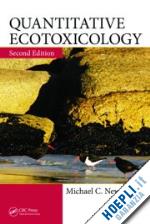IntroductionEcotoxicology as a Scientific DisciplineToxicants and BiosphereToxicant Effects in EcosystemsToxicant Fate in EcosystemsOrganization of Knowledge Based on Explanatory PrinciplesBayesian InferenceToward Strongest Possible Inference and Clear Ecological RelevanceReferencesThe Measurement ProcessGeneralRegions of QuantitationBlank CorrectionAccuracy and PrecisionVariance StructureSample SizeOutliersSummaryReferencesBioaccumulationGeneral Modeling Bioaccumulation: General ApproachModeling Bioaccumulation: Alternative ApproachesIntrinsic Factors Affecting BioaccumulationSummaryReferencesLethal and Other Quantal Responses to StressGeneralDose-Response at a Set EndpointTime to DeathQuantifying the Effects of Extrinsic FactorsQuantifying Effects of Intrinsic FactorsToxicant MixturesSummaryReferencesStatistical Tests for Detection of Chronic Lethal and Sublethal StressGeneralMethod SelectionOne-Way Analysis of VarianceTest of Normality: Shapiro–Wilk’s TestTest for Homogeneity of Variances: Bartlett’s TestTreatment Means Compared to the Control MeanMonotonic Trend: Williams’s TestSteel’s Multiple Treatment-Control Rank Sum TestWilcoxon Rank Sum Test with Bonferroni’s AdjustmentA Second Look at Statistical TestingInferring Biological Significance from Statistical SignificanceSummaryReferencesPopulation and Metapopulation EffectsGeneralEpidemiologyPopulation SizeDemographySpatial Distribution of IndividualsPopulation GeneticsSummaryReferencesCommunity EffectsGeneralSimple Species InteractionsCommunity Structure and FunctionComposite IndicesMetacommunitiesTrophic ExchangeSummaryReferencesSummaryApplicationFacilitating Growth of the ScienceReferences Appendices Appendix 1: Factors for Estimating Standard Deviation and Control Limits for Range Appendix 2: One-Sample Tolerance Probability Comparisons between nm* and nm Appendix 3: Critical Values of T Used to Test for Single Outliers (One-Sided Test) Appendix 4: Critical Values for ? Used to Test for Multiple Outliers (a = 0.05) Appendix 5: Response Metameters for Proportion Affected Appendix 6: Maximum Likelihood Values for Dixon’s Up-and-Down Method Appendix 7: E Values Used to Estimate 95% Confidence Intervals for LT50 with the Litchfield Method Appendix 8: Coefficients (an–i+1) for Shapiro–Wilk’s Test for Normality Appendix 9: Percentage Points of Shapiro–Wilk’s W Test for Normality Appendix 10: Dunnett’s t for One-Sided Comparisons between p Treatment Means and a Control for a = 0.05 Appendix 11: Dunnett’s t for Two-Sided Comparisons between p Treatment Means and a Control for a = 0.05 Appendix 12: Bonferroni’s Adjusted t Values for One-Sided Test and a = 0.01 Appendix 13: Bonferroni’s Adjusted t Values for One-Sided Test and a = 0.05 Appendix 14: Bonferroni’s Adjusted t Values for Two-Sided Test and a = 0.01 Appendix 15: Bonferroni’s Adjusted t Values for Two-Sided Test and a = 0.05 Appendix 16: Dunn–Šidák’s t for Comparisons between p Treatment Means and a Control for a = 0.01, 0.05, 0.10, and 0.20 (One-Sided Test) Appendix 17: Dunn–Šidák’s t for Comparisons between p Treatment Means and a Control for a = 0.01, 0.05, 0.10, and 0.20 (Two-Sided Test) Appendix 18: Williams’s ti,a for w = 1 and Extrapolation ßt (Superscript) for a One-Sided Test and a = 0.01 Appendix 19: Williams’s ti,a for w = 1 and Extrapolation ßt (Superscript) for a One-Sided Test and a = 0.05 Appendix 20: Williams’s ti,a for w = 1 and Extrapolation ßt (Superscript) for a Two-Sided Test and a = 0.01 Appendix 21: Williams’s ti,a for w = 1 and Extrapolation ßt (Superscript) for a Two-Sided Test and a = 0.05 Appendix 22: Significant Values of Steel’s Rank Sums for a One-Sided Test with a = 0.05 or 0.01 Appendix 23: Significant Values of Steel’s Rank Sums for a Two-Sided Test with a = 0.05 or 0.01 Appendix 24: Wilcoxon (Mann–Whitney) Rank-Sum Test Critical Values with Bonferroni’s Adjustments: One-Sided Test and a = 0.05 Appendix 25: Wilcoxon Rank-Sum Test Critical Values with Bonferroni’s Adjustments: Two-Sided Test and a = 0.05 Appendix 26: SAS Code for Implementing the Jonckheere–Terpstra Test Appendix 27: Balancing a, ß, and Effect Size (ES) Appendix 28: Basic Matrix Methods Appendix 29: Values of ? Used for Maximum Likelihood Estimation of Mean and Standard Deviation of Truncated Data Index











